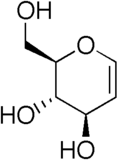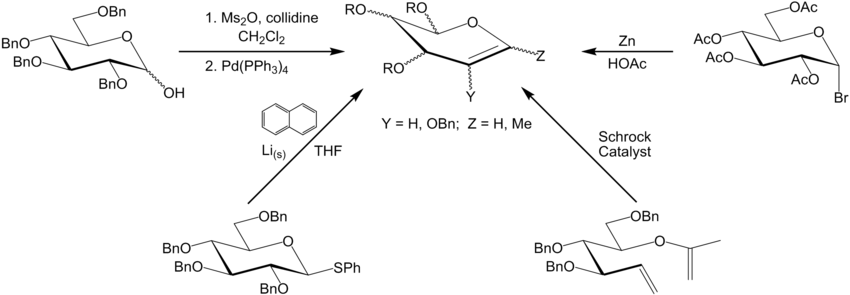Glycal
Glycal is a name for cyclic enol ether derivatives of sugars having a double bond between carbon atoms 1 and 2 of the ring. The term “glycal” should not be used for an unsaturated sugar that has a double bond in any position other than between carbon atoms 1 and 2.[1]

History
The first glycal was synthesized by Hermann Emil Fischer and Karl Zach in 1913.[2] They synthesized this 1,2-unsaturated sugar from D-glucose and named their product D-glucal. Fischer believed he had synthesized an aldehyde, and therefore he gave the product a name that suggested this.[3] By the time he discovered his mistake, the name “glycal” was adopted as a general name for all sugars with a double bond between carbon atoms 1 and 2.[4]
Conformation

Glycals can be formed as pyranose (six-membered) or furanose (five-membered) rings, depending on the monosaccharide used as a starting material to synthesize the glycal. Glycals can also be classified as endo-glycals or exo-glycals. A glycal is an endo-glycal when the double bond is within the ring. If the hydroxyl group on carbon 1 has been replaced with another carbon atom, a double bond can also form outside the ring between carbon 1 and this new carbon. In this case, the product is called an exo-glycal.[5] The glycal conformation that has been studied in most depth is that of the pyranose endo-glycal. The favoured conformation of this glycal is the half-chair,[6] a result which has been confirmed by quantum mechanical calculations.[7]
Synthesis
The original Fischer glycal synthesis was the reductive elimination with zinc of a glycosyl halide. This glycosyl halide was formed from a monosaccharide starting material.[8] Some other synthetic routes include:
- Ring-closing metathesis [9]
- Reaction of thioglycosides with lithium napthalenide.[10]
- Mesylation of the anomeric hydroxyl and formation of the anomeric palladium complex, which undergoes beta-elimination[10]
A general example of each synthetic route is given below (drawn with first discussed synthesis bottom right, moving clockwise):

Reactions and uses
The double bond of a glycal allows many other functional groups to be introduced into a monosaccharide. Like an alkene, a glycal can undergo electrophilic addition across the double bond to add in these new atoms such as halogens, epoxides, and nitrogen. The glycal double bond also allows a deoxy position (carbon in the ring that doesn’t have an oxygen bonded to it) to be easily introduced.[8]
Glycals have many uses in synthetic carbohydrate chemistry. They are commonly used as glycosylation donors, meaning that they can react with other monosaccharides to form a longer chain of monosaccharides called an oligosaccharide.[11]
Glycals can also have interesting applications in studying biological systems, particularly enzymes. D-glucal and radiolabelled D-galactal have been used to selectively bind with amino acids in the active sites of several enzymes. These enzyme-glycal complexes allow these amino acids that are essential for catalysis to be identified and allow for a better understanding of how these enzymes function.[12]
References
- IUPAC "Nomenclature of Carbohydrates"
- "Archived copy". Archived from the original on 2009-06-05. Retrieved 2018-11-30.CS1 maint: archived copy as title (link)
- Lindhorst, T.K. (2007). Essentials of Carbohydrate Chemistry and Biology. Wiley-VCH. ISBN 3-527-31528-4.
- Fraser-Reid, B.O.; Tatsuta, K.; Thiem, Joachim (2001). Glycoscience: Chemistry and Chemical Biology I - III. Springer. ISBN 3-540-67764-X.
- Taillefumier, C.; Chapleur, Y. (2004). "Synthesis and Uses of exo-Glycals". Chemical Reviews. 104 (1): 263–292. doi:10.1021/cr030640v. PMID 14719977.
- Pigman, W.W.; Wolfrom, M.L.; Tipson, R.S. (1950). Advances in Carbohydrate Chemistry. Academic Press. ISBN 0-12-007226-2.
- Ernst, C.; Piacenza, M.; Grimme, S.; Klaffke, W. (2003). "Epoxidation of C-branched glycals: unexpected stereochemical results and their theoretical rationale". Carbohydrate Research. 338 (3): 231–236. doi:10.1016/S0008-6215(02)00406-8. PMID 12543555.
- Lindberg, T.J.; Harmata, M.; Wender, P.A. (2004). Strategies and Tactics in Organic Synthesis. Academic Press. ISBN 0-12-450287-3.
- Calimente, D.; Postema, M.H.D. (1999). "Preparation of C-1 Glycals via Olefin Metathesis. A Convergent and Flexible Approach to C-Glycoside Synthesis". The Journal of Organic Chemistry. 64 (6): 1770–1771. doi:10.1021/jo982331o. PMID 11674258.
- Somsk, L. (2001). "Carbanionic Reactivity of the Anomeric Center in Carbohydrates". Chemical Reviews. 101 (1): 81–136. doi:10.1021/cr980007n. PMID 11712195.
- Danishefsky, S.J.; McClure, K.F.; Randolf, J.T.; Ruggeri, R.B. (1993). "A Strategy for the Solid-Phase Synthesis of Oligosaccharides". Science. 260 (5112): 1307–1309. Bibcode:1993Sci...260.1307D. doi:10.1126/science.8493573. PMID 8493573.
- Sigman, D.S. (1992). Mechanisms of Catalysis. Academic Press. ISBN 0-12-122720-0.